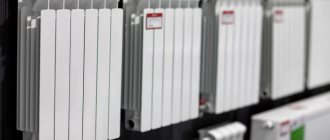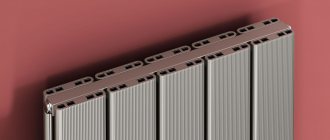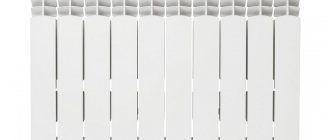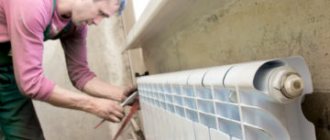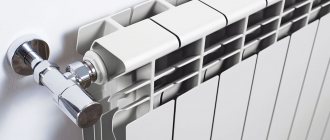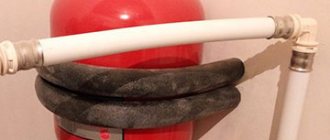To assemble aluminum heating radiators, we will need: an American universal wrench and a ring wrench.
Note: when using metal wrenches - spanners and especially open-end wrenches, there is a high probability of damaging the finishing coating on the surface of the listed products, as happened in my case, so pay attention to this removal and do not repeat my mistake. I recommend using a plastic wrench for radiator caps, footers and air vents, an example of which is shown in the photo.
Dismantling cast iron radiators
To dismantle such heating devices yourself, you will need the following tool:
Dimensions of cast iron battery.
- Pipe wrench number 3, for loosening the locknut and fitting.
- Pipe cutter for cutting pipes or grinder.
- Hacksaw for metal.
- Chisel.
- Hammer and sledgehammer.
- Brush for removing rust.
Work to dismantle such heating devices is usually carried out in the summer, when the heating system is turned off. Before starting dismantling work, it is necessary to drain the water from the heating pipelines.
Then, using a pipe wrench, the locknuts located on the water supply pipes are unscrewed, the fittings are unscrewed, and the radiator is removed from the brackets.
If the locknuts cannot be unscrewed, the coolant supply pipes are cut off and the device is dismantled.
Causes of breakdowns
As in the case of the sleigh in the famous saying, the heating system should be prepared for the new season in the summer.
The main causes of problems are:
- Low heating of the aluminum battery when there is no air in it.
- Noises and knocking are heard in the system.
- The aluminum radiator was found to be leaking.
- Plaque appeared at the joints of system elements.
In houses with autonomous heating, these problems can be easily identified by running the system at maximum operating mode. Higher pressure will show the integrity of the structure and allow you to see possible defects in it. In houses with centralized heating, it will not be possible to carry out such work on your own, but you can submit a request to the management service that their specialists have carried out the necessary work.
If during testing the system showed its best side, but problems began at the height of the season, then emergency dismantling of the radiator is required.
To do this you need to do the following:
- The shut-off devices are closed, as is the riser (the media must first be drained from it).
- A container for draining the coolant is installed under the bottom connection.
- Unscrew the lower ball valve so that the water (antifreeze) remaining in the battery drains out.
- The top valve is also unscrewed and the battery is removed from the brackets.
If the question arises of how to repair an aluminum heating radiator if it does not heat, then you should look for the reason for this condition of the device:
- The first thing you need to do is bleed the air from the system and wait until the batteries warm up.
- If nothing has changed, then you will have to dismantle the radiator and check for the possibility of clogging . Sectional aluminum radiators do not hold much coolant. By pouring water into the removed heater, you can calculate whether its quantity corresponds to the parameter stated in the data sheet. If not, then it is not necessary to repair the aluminum heating radiator, but to flush it , for which you should pass water under high pressure through the structure until it brightens.
- If the flow of water did not “cope” with the task, then you will need knowledge of how to disassemble an aluminum heating radiator into sections and do the same work with each element separately . Sometimes, when very dirty, a brush (not metal) is required to rid the battery of thick dirt.
Sometimes the only way to return the batteries to a hot state is to replace the aluminum radiator section or extend them. With the lateral type of connection this will not be difficult, whereas with the bottom or diagonal method you will have to increase or shorten the length of the pipe.
Marking the mounting locations
Mounting installation begins with determining where and how the heating device will be placed . The best place is a wall under a window or close to the door. In both cases, the heat that the sections will generate will become a barrier to the movement of cold air.
Installation of fastenings always begins with markings:
- The battery must be placed strictly in the center of the window . The maximum deviation of the center of the device from the center of the opening should not exceed 2 cm. The marking involves drawing a vertical line on the wall. It should be in the center of the window. Next, marks are made on the sides, retreating to a distance equal to half the assembled heating radiator.
- between the floor and the bottom of the cast iron structure .
- There should be 10-12 cm between the window sill and the top of the heating radiator . In accordance with these two rules, horizontal marks are made.
You also need to draw the marks along which the brackets will be installed. First, draw lines that will correspond to the levels of the supports. The top one needs to be drawn below the marks made near the window sill. The distance to them should be equal to the distance between the top of the heating radiator and the lower point of connection of the two sections. The bottom line is drawn above the marks made near the floor. It is raised as many centimeters as there are between the lower points of the section and the connection of the ribs. On these lines, mark with your own hands the places where the brackets should be. It is taken into account that for every 5 ribs there should be 1 fastening, both above and below.
Harness
Which shut-off and control valves are mounted on the connections in front of the passage plugs?
Here are some typical options.
- Pair of ball valves. They allow you to completely turn off the device in case of repair or replacement without resetting the entire circuit.
A pair of valves completely cuts off the device from the connections.
- Throttle and ball valve. The throttle provides the ability to manually adjust heat transfer.
- A pair of chokes makes it possible to perform basic balancing of the system (limiting the passage of heating devices closest to the boiler) and subsequently regulate the heat transfer of the device.
- Finally, the combination of a throttle with a thermal head makes it possible to adjust the heat transfer completely automatically: the set temperature will be maintained in the room with acceptable accuracy.
Dismantling cast iron radiators
The most common are cast iron radiators MC140. During their operation, which in some cases is 30 years or more, they have shown themselves only at their best:
- accumulates heat;
- resistant to poor quality coolant;
- ease of maintenance;
- reliable and have a long service life (from 10 years and above)
How to disassemble this grandfather? And it’s very simple, because structurally all radiators are assembled according to the same principle: using nipple nuts and gaskets for tightness. True, in those ancient times, tow with paint was screwed onto the nut and there was a rubber gasket.
Cast iron radiators in some systems last for 50 years, it is clear that disassembling them will not be easy
There are no problems disassembling the new radiator. But you’ll have to tinker with the old one:
- Over time, the joint between the sections “sticks”;
- the internal protrusions for the key are corroded by the coolant.
This is why dismantling the old “cast iron” is quite problematic.
Another difficulty in working with cast iron is its heavy weight. The weight of one “clean” section is 7.5 kg. A 10-section battery weighs 75 kg, so it’s best to carry it with two people. Before disassembling the radiator, it is best to remove and wash it. A battery that is light in weight can be washed in the bath, after laying down a rag. To do this, it is best to take a piece of hose, connect it to a cold water tap and rinse thoroughly. If you hate to dirty the bathtub, you can go out into the yard. All that matters is the presence of water, you also need a drain: there will be more than enough of any horror in the water.
Only a strong person can carry cast iron batteries alone
The place for disassembling the radiator is chosen to be level and quite spacious. If you live in a multi-story building, then this work can be done on the staircase. Tools you will need:
- radiator key;
- chisel, hammer, small sledgehammer;
- brush with metal bristles, blowtorch;
- several boards or blocks for lining under the battery;
- plumbing wrench No. 2,3 for unscrewing side plugs (footers) and plugs.
A few words about the key: you are unlikely to find something like this in a store; it’s easier to look in the market or borrow from a plumber you know.
The key is a round rod with a diameter of 18 mm. On one side it is flattened in the form of a spatula to the internal size: its width is 28x40 mm and its thickness is 6 mm. On the other hand, a ring is welded to it, into which a lever is inserted for rotation. The length of the key is defined as ½ the length of the largest radiator plus approximately 300 mm. You can make such a “miracle” from a suitable piece of half-inch pipe by flattening one end. But this option is only suitable for disassembling a new radiator.
The joint is leaking - the gasket is leaking. It is necessary to disassemble the cast iron battery and change it
To make work easier, before disassembling the joint must be heated with a hair dryer or a blowtorch. This is where you need boards: you place the radiator on them and heat it.
What to consider when choosing
When purchasing a regular installation package, you should decide on the diameter of the heater’s connecting hole. Some boiler equipment manufacturers may give specific installation recommendations, which will include the type of faucet connection kit. You should pay attention to such recommendations in order to avoid damage to thermal convectors. Fittings produced by well-known manufacturers are more reliable.
If the choice falls on a universal set, which also contains fasteners, it is worth considering that for heavy cast-iron radiators you should take special long steel pins to be able to bury them into the thickness of the wall; for light models of heaters, brackets screwed with screws are sufficient.
It does not matter which unit is installed in the thermal circuit - aluminum or bimetallic - they are not adapted for conventional plumbing fittings due to the fact that on the right side, if you look at the front panel, they have holes with a right-hand thread, and on the left side, accordingly , there is a left cut. Left-sided fittings solve the issue, allowing valves, valves and plugs to be connected to them.
When buying a set, you need to carefully check the direction of the turns of the holes on the fittings; it should be different in pairs.
Installation
How and with what do you tighten the plugs in heating radiators when installing them? How to seal connections? The instructions depend on the cork material.
The fitting is screwed into aluminum radiators using an adjustable or open-end wrench. Tightness is ensured by a standard paronite or silicone gasket.
The gasket under the plug is clearly visible in the photo.
The plugs for cast iron heating radiators are screwed in with gas wrenches No. 2 - 4.
The procedure is as follows:
- The carving is made with your own hands, without the use of tools.
- In the gap between the bottom of the plug and the section, a strand of plumbing flax impregnated with any quick-drying paint or silicone sealant is placed along the pipe thread.
- The fitting is tightened until excess impregnation is squeezed out.
Connection to a two-pipe system
A two-pipe system consists of parallel pipes connected to two heaters. Such a system should be installed in large private houses or industrial areas. The type of connection depends on the type of two-pipe connection:
- Associated heat movement is the most common scheme in the construction of houses and apartments. This is a parallel, equal in distance, movement of heated water. It is necessary to connect aluminum batteries to such a system in a diagonal way, but all others can be connected, depending on the pipe layout.
- Deadlock traffic . With it, the water to the last battery travels the longest way from the main heater and the shortest from the opposite one. Using this scheme, you can connect radiators of any type. You need to install regulators and valves into the system yourself.
- The gravity flow pattern is determined by convection. It requires diagonal connection of aluminum radiators.
Accessories for heating radiators. Installation and features
The principle of connecting different types of heating batteries is almost the same, but they differ in the equipment used for this. Accessories for radiators are offered for sale individually, as well as in sets, which contain all the products required to connect one battery.
Popular types of heating radiators
In the vast majority of apartments and houses you can find 4 types of heating batteries:
- Cast iron.
- Aluminum.
- Bimetallic.
- Steel.
There are also plastic and copper radiators, but they are practically not used. Each type of popular battery type has its own specific performance characteristics and connection method. The only exceptions are aluminum and bimetallic radiators, the connection principle of which is identical, as are the components used for this.
Cast iron batteries
Heating radiators of this type have been widely used in the past due to their high resistance to corrosion and oxidation. Despite their massiveness and high cost, they are still relevant today. The fact is that in central heating systems the circulating coolant is too contaminated, so batteries made of other materials wear out in just a couple of years.
Aluminum radiators
Such batteries have an attractive appearance. Aluminum has high thermal conductivity, which means it heats up the air in the room faster. A huge disadvantage of such batteries is their high sensitivity to the chemical composition of the coolant. In this regard, they are completely unsuitable when connected to a central water supply. They are chosen only when an autonomous heat supply is being installed, since it is possible to control the quality of the fluid circulating in the system.
Bimetallic radiators
Batteries of this type have high heat transfer because they contain aluminum. They are very durable and have a long service life. They have a higher cost, which significantly reduces the popularity of this type of radiator.
Steel radiators
Steel batteries, unlike all previous varieties, are not collapsible. They do not consist of sections that can be removed and added at will. Typically, such radiators are of a panel type. Outwardly they look like a rectangular box. They can often be found in office buildings, as well as in residential buildings and apartments. Since panel systems are not dismountable, manufacturers often install on them all the necessary components for radiators from the factory.
Accessories for connecting radiator sections
Cast iron, aluminum and bimetallic batteries consist of sections, the ribs of which can be removed or added, thus adjusting the efficiency of heating the room.
To increase the battery, the following products are used:
- Nipple.
- Pad.
The barrel nipple can have a different diameter, depending on what type of battery it will be used for. The largest connector is used when installing old-style cast iron radiators. The nipple is a short metal tube, on opposite ends of which multidirectional external threads are cut, reaching to the center. Inside the nipple there is a special groove designed to fix the key for assembling batteries.
Steel panel radiators are an excellent choice at a competitive price
Panel radiators made of steel are the most popular heating devices in the CIS, as well as in the European Union. These devices are widely used for heating residential premises, administrative buildings, and industrial facilities. Steel panel radiators are very popular along with bimetallic and aluminum ones. Steel panel heating radiators are ideal for installation in low-rise buildings. They provide thermal comfort, are lightweight, economical, and easy to install. It is difficult to find a more suitable option for an autonomous heating system. However, like all other types of heating devices, they have a number of advantages and disadvantages. In order not to make a mistake when purchasing, you need to familiarize yourself in detail with their types, technical and operational characteristics.
Installation of steel panel radiators for the home
The internal structure of these devices is as follows: sheets of metal are welded together with symmetrical recesses. Water (coolant) circulates through recesses and channels. To increase thermal conductivity, metal fins are attached to the inside of the device. One of the advantages of steel panel radiators is the perfect combination with any design. Heating devices made of steel are installed in buildings of any purpose.
What is the secret of popularity
- Let's start with the fact that such units are considered perhaps the most durable . Most reputable manufacturers confidently offer a 50-year warranty. And this is quite justified, for example, in Tsarskoe Selo, a radiator installed 110 years ago is still functioning;
Important: there is an opinion that the cast iron radiator now is worse than in Soviet times. This is only partly true. It all depends on the quality of the product and the manufacturer. If the battery is cast in accordance with domestic or European GOST standards, then there is nothing to be afraid of. But when purchasing units from Chinese or Turkish “masters”, a person is essentially taking a pig in a poke.
Standard MS 140.
- Cast iron, although a brittle metal according to its characteristics, is still quite durable . The working pressure for such a battery is 8 – 12 atmospheres, plus during short-term surges or water hammer, it can withstand a load of up to 20 atmospheres. If we take into account the fact that in the urban network the pressure rarely exceeds 6 - 8 atmospheres, and the average water hammer force is 15 - 20 atmospheres, then the safety margin is obvious;
- Such batteries are present both in the budget segment of the market and in luxury goods . The fact is that the price of the classic MS-140 is perhaps the lowest. At the same time, the cost of artistic thick-walled casting can sometimes be several times higher than the price of good bimetal;
- Adherents of modern materials forget about the quality of the coolant in our urban networks . This harsh “cocktail” can destroy many newfangled models. While cast iron is completely resistant to all chemical attacks and neutral to corrosion, it simply does not rust;
Design of modern cast iron batteries.
- Thanks to the large diameter of the battery channels, any debris slips through it, practically without stopping , which is very important for urban high-rise buildings with old pipework;
- As you know, cast iron has a high heat capacity . The battery takes a long time to gain temperature, but also maintains it for a long time. In case of interruptions in heating, this unit will give off heat for several hours after switching off;
Battery connection options.
- Technically, installing a cast iron heating radiator with your own hands is not very difficult . With a tool and a couple of assistants for support, the job can be completed within a day;
- Another important advantage is the fact that components for cast iron heating radiators can be found in any hardware store and the price for them is quite reasonable;
Characteristics of modern cast iron radiators.
We seem to have figured out the reasons for the nationwide popularity.
Now let's talk about the pitfalls of these heating devices:
- The first reason why many people refuse cast iron is the serious weight of the structure. Judge for yourself, a standard section weighs about 7 kg; on average, 7 – 10 sections are installed per room. As a result, we have from 50 to 70 kg of empty structure; when filling, another 1 - 1.5 kg is added to each section. In addition to installation problems, not every wall can support such a unit;
- The minimum volume of coolant in one cell is about 1 liter. For modern competitors this figure is 3–5 times less. And as you know, the more liquid, the more energy is required to heat it and maintain temperature. Plus, it is very difficult to quickly regulate the temperature in such systems, due to their high inertia;
Data of the classic cast iron radiator MS 140.
- The area of such structures, compared to modern analogues, is somewhat smaller, and accordingly the heat transfer is lower;
- Reproaches regarding the unattractive design are unfounded; to some extent they can be addressed to the widespread MS-140. As for figured casting, their beauty leaves them far behind their modern counterparts;
Problems
What problems with sectional heating devices are somehow related to nipples?
Intersectional leaks
The reason for their appearance is that the gaskets between the sections tightened by the nipple gradually lose their elasticity due to prolonged heating and liming. With each heating and cooling, the linear dimensions of the sections change slightly; in this case, the gasket is deformed over and over again.
Finally, when the battery cools again, it stops completely blocking the gap between the section collectors, and moisture appears at the junction.
Leak between sections.
Nipple rupture
The consequences of a nipple rupture are much more unpleasant. If in the first case the worst thing that threatens you is a small puddle under the battery, then disconnecting one of the collectors risks flooding your and neighboring apartments with hot water with a large amount of silt and sand.
What could cause a fairly strong nipple to rupture?
- Connection overtightened during assembly . As already mentioned, the sections expand somewhat when heated; As soon as the coolant temperature rises, the barely visible crack will expand and turn into a source of serious problems.
- Water hammer . This is the name of a wave propagating in a practically incompressible medium, created by an abrupt stop in flow when the valve of a screw valve is torn off, the cheek of a valve falls, or simply the shut-off valve is suddenly closed. The pressure at the flow front during water hammer can reach 20 – 25 atmospheres.
The mechanism of water hammer occurrence.
Reference: cast iron radiators are designed for a working pressure of 9-12 atmospheres, aluminum radiators - 6-16.
Design of heating radiators
A standard battery is assembled from individual cast sections, without the use of external fasteners or retainers. Thus, you can build a radiator of almost unlimited length.
To properly disassemble a cast iron battery, you need to know some features of its design:
- The individual sections are assembled into one housing using internal threaded bushings or nipples. To disassemble a cast iron radiator, you need to be able to remove the end plugs and internal inserts;
- Each nipple is a cylindrical glass, on which two sections are cut with threads of two types - with left and right directions of turns.
End caps are also manufactured with two types of threads; as a rule, blind plugs are produced with a left-hand thread, and the fitting nut for connecting to a pipe is produced with a right-hand thread.
To secure a separate register into a common cast-iron body, a pair of nipples are used, which are simultaneously screwed between the two sections with a long key with a square head. In order to disassemble and avoid splitting the cast iron body, you will also need to carefully unscrew the nipples, making only 1-2 turns on each.
Classification
Plugs for heating radiators can be divided into groups according to several criteria.
Material
As a rule, it corresponds to the radiator material:
- For a cast iron battery, a cast iron radiator plug is used;
- For sectional steel and bimetallic radiators, steel pipe fittings are purchased.
However: for aluminum batteries, with rare exceptions, not aluminum, but the same steel products are used. The aluminum plug is too easily damaged when screwing in and installing the trim; in particular, 1/2-inch diameter threads cut into aluminum can be stripped with very little force.
Steel fitting for aluminum and bimetallic batteries.
Thread
It can be right-handed (screwed in clockwise) or left-handed. As a rule, the left plug for a cast iron radiator and the steel plug made in Russia for aluminum/steel/bimetallic devices are marked with the letter “L”.
If there is no marking, it is not difficult to identify the type of thread: it is enough to trace one of its threads over a couple of turns.
Functions
With a blind plug, everything is simple and clear: its only function is to plug the threads of the end section.
The pass-through radiator plug is used to connect the insulation and/or piping elements to the heating device. In fact, it is an adapter for a thread of a smaller diameter. The thread on the section depends on the material of the heating device:
| Battery Type | Thread size |
| Cast iron | DN32 (1 1/4 inches) |
| Aluminum, bimetallic | DN25 (1 inch) |
The diameter of the thread connected to the passage plug can also be different:
| Battery Type | Thread size |
| Cast iron | DU15, DU20, DU25 |
| Aluminum, bimetallic | DU15, DU20 |
Cast iron plug for liner with diameter DN20.
It’s curious: when connecting a 25 mm diameter line to a cast iron battery, not a drilled plug is used, but an ordinary cast iron adapter DU25-DU32.
In some cases, the harness or liner may not use through-hole plugs for connection, but directly the thread of the end section manifold.
When is this practiced?
- When connecting cast iron batteries to the filling gap in a system with natural circulation. The maximum filling diameter is important here - it affects the hydraulic resistance of the circuit; therefore, the DN32 pipe is screwed directly into the sections.
- When installing a welded flush valve. These products are also, as a rule, made to fit the thread size of the sections themselves.
- When installing the air vent. Many manufacturers produce Mayevsky taps and automatic air vents for DU25 threads.
How to make old batteries look aesthetically pleasing
Once you have cleaned the inside of the batteries and replaced any worn gaskets, the job of upgrading the functionality is complete. It's time to take care of the appearance so that the heating devices fit well into the interior. To do this, just paint them. If desired, the batteries are decorated with original painting, images using the decoupage technique, or simply covered with special screens. But you will have to paint it anyway. It is important to choose the right paint composition and follow the application technology.
Subtleties of choosing radiator paints
Radiator paints are subject to increased requirements. They must be resistant to high temperatures, wear-resistant, and safe. It is also important that the coating does not reduce thermal conductivity. Manufacturers offer the following compositions:
- Acrylic enamels
These are organic based paints. With their help it is easy to create a beautiful coating with a glossy shine. Disadvantage: pungent odor. Until the paint dries, a specific aroma will be felt in the room.
- Alkyd enamels
Advantages: large selection of shades, good performance characteristics, durability. The drawback is the same - the smell. Moreover, it can appear when the batteries are very hot during the heating season.
- Water-dispersed compositions
They are often chosen due to their lack of odor and quick drying. When purchasing, pay attention to the manufacturer. There must be a mark on the can that the paint is intended specifically for heating radiators.
- Oil paints
They are sometimes bought for batteries, but this is the worst choice. Oil formulations have many disadvantages. They take a long time to dry, smell strongly, change color, and reduce the heat transfer of radiators.
Make sure that the paint you choose is marked “For heating radiators” and “Heat resistant”
Radiator paint application technology
The coating must be removed before painting. Stores sell special paint removers, you can use them. In theory, washes help clean batteries, but in practice their effectiveness leaves much to be desired, because the paint literally sticks to surfaces under the influence of high temperatures. It is better to heat the coating with a blowtorch or a hair dryer, clean it with a spatula and a brush with metal bristles. After this, sand the surface with sandpaper and degrease.
You need to paint it like this:
- First, the internal surfaces are painted to prevent drips from appearing on the front of the battery.
- The brush or roller is applied from bottom to top.
- Drips are removed immediately before the paint thickens.
- The coating is applied to the entire surface of the radiator; there is no need to leave unpainted areas.
- You can make a single layer coating, but it is better to paint in two layers to achieve greater durability.
Floor-standing cast iron battery, painted in ombre style
An old cast iron radiator can create comfort in your home for several decades. Do not throw away the device if it has lost its presentable appearance and began to heat worse. All problems can be solved. Restore the battery, show your imagination - and the heating device will work and look no worse than new.
Application of punching knives
The operating principle of this method is similar to die cutting, but in this case a simpler and less expensive tool is used. The production of seals in this way is inexpensive and quite fast. However, the pants are quite short-lived, so this technique is used for the production of small and medium-sized batches of gaskets.
General recommendations
Experienced craftsmen and professionals recommend taking into account the following points:
- When using a cast iron radiator plug on heating appliances, caution should be exercised. The fact is that cast iron is easily compressible, but is considered a rather fragile material. Therefore, even a slight mechanical impact or impact on a hard surface can cause the formation of microcracks. As for steel products, they are more reliable in this regard.
- When studying materials for the assembly and installation of heating devices, there are recommendations for using ordinary paint for more airtight connections. To some extent, these statements are true, but it should be noted that such connections do not have a very attractive appearance, and when disassembling them you may encounter certain difficulties. It is important to understand that modern heating devices and their additional accessories do not require painting.
Selecting and installing radiator plugs is not difficult, but you need to approach this process quite responsibly. It is very important to select matching materials, correctly determine the type of thread and size of the plug, as well as its purpose. By following the recommendations of professional technicians, you can avoid many problems during the operation of the heating system, including batteries and radiators.
Thermal molding
In this case, you will need an injection molding machine with a mold for casting products. The cost of a molding press is quite high, so in order to make production economically feasible, the production of gaskets using this method must be large-scale or even mass-produced.
The production of products in small batches using this technology is relevant only if they cannot be produced in any other way. It is noteworthy that only PVC seals are produced by thermoforming.
Cutting with circular knives
Only large round seals can be produced using this method. In the process of work you will need fairly cheap and high-performance equipment. Cutting is carried out with standard blades. Therefore, the production of gaskets of this type can be carried out independently and in any volume. Radiator leaks are often caused by a damaged gasket. And if you don’t know what to do if the heating battery leaks, first of all you should pay attention to the gaskets.
Types of heating devices
There is no official classification of cast iron batteries. We can roughly divide heaters into 3 types:
- Soviet-style “accordion” type MS-140;
- devices with an increased heat exchange area, simulating new bimetallic and aluminum heaters, only cast from cast iron;
- designer batteries made in retro, modern style.
Comment. Let us remind you: all cast iron heating devices are sectional, that is, stacked.
It is unrealistic to classify products based on other criteria. Technical characteristics - weight, dimensions, heat transfer - vary widely. Let's look at the properties of batteries by group.
Pros and cons of traditional accordions
To begin with, we present the technical parameters of one fin of the MS-140M radiator, taken from the technical data sheet:
- total height – 588 mm, between holes – 500 mm, depth – 14 cm (the number is included in the marking);
- heat flow (power) – 160 W, surface area – 0.21 m²;
- working pressure – no higher than 10 Bar;
- the volume of water inside the section is 1.45 liters, the maximum temperature is 130 °C;
- weight – 7.12 kg;
- material – gray cast iron SCh-10, plugs – malleable cast iron KCh-30 or steel;
- gaskets - rubber.
Dimensions of the MS-140 heater and recommended installation distances
Note. The amount of heat flow is indicated under certain operating conditions: the difference Δt between the temperature of the room air and the coolant is 70 degrees. The calculation of heat transfer of section 1 is described in a separate instruction. The letter "M" in the marking means "modernized".
“Accordions” are produced by several Russian enterprises and the Minsk Heating Equipment Plant. The average price for a MS-140M battery section is 10 USD. e., minimum – 6 cu. e.
The mentioned Belarusian plant also produces modified versions of “accordions”, shown in the photo below:
- lightweight model 2K60 with a power of 120 W, the fin weighs 5.1 kg;
- 2KP100-90-500 depth 9 cm, heat output - 140 W;
- modification BZ-140-300 with an interaxial distance of 30 cm, power - 120 W.
The undoubted advantages of radiators remain their affordable price, durability and corrosion resistance to chemically active substances. However, the latter advantage is inherent in all batteries made of cast iron.
- Soviet “accordions” of the MC type do not meet current interior design requirements. The new modifications look better.
- Fragility. A slight impact can cause a microcrack to form in the metal, and then a leak. Freezing of the coolant definitely leads to destruction; the expansion of water causes cast iron to split.
- Significant mass of the heating device, aggravated by spaciousness. Due to the coolant, each section is made heavier by 1-1.5 kg. The multi-section heater cannot be hung on a wall made of aerated concrete or a plasterboard partition, only placed on the floor.
- Limited scope. Due to the maximum operating pressure of 10 Bar, the radiator cannot be used in an apartment with central heating, where the water pressure reaches 12 Bar (at the time of testing the network).
- There is no bottom connection to the heating system, pipes are connected only from the side.
Inertia (long heating and cooling) cannot be attributed to the pros or cons of radiators. This is a feature of thick cast iron walls that does not affect the quality of heating.
Important note. The efficiency of the boiler and the efficiency of the system do not depend on the amount of water in the batteries. The load on the circulation pump is like fairy tales. If the volume of coolant is large, then only the time of initial heating and final cooling will change. Listen to the expert's opinion in the video:
It is worth mentioning one more advantage of the M-140 series batteries. Since “accordions” were previously used everywhere, working sections can be found for free or purchased from scrap metal. According to reviews from owners of private houses, used cast iron radiators are often used for heating outbuildings and utility rooms.
Radiators with increased heat transfer area
The uniformity of the shapes of cast iron appliances is due to the manufacturing technology - casting. The extrusion method used to produce aluminum sections is not applicable here. But in recent years the picture has improved - products with a flat front panel and side ribs, reminiscent of light alloy heaters, have appeared on the market.
Reference. The aluminum-look batteries shown in the photo are produced by Russian, Belarusian and Chinese companies: Konner, STI NOVA, Minsk Plant.
As an example, we list the characteristics of the KONNER Modern section with a standard center distance of 500 mm:
- total height – 60 cm, depth – 96 mm;
- heat transfer at Δt = 70 °C is 150 W;
- maximum water pressure in operating mode – 12 Bar;
- capacity – 0.9 liters;
- weight – 4.1 kg.
The outside of the heater is covered with polymer enamel (usually white). Gaskets are EPDM rubber, the kit includes 4 end plugs. The cost of one KONNER Modern rib is 500 – 12 USD. That is, at least 4 pieces are sold. For rooms with low window sills there is a series of low KONNER G1 batteries with a center distance of 300 mm and a power of 120 W.
Externally, Konner heaters are very similar to products made of aluminum alloy - the front section is flat, heat exchange fins are cast on the sides
How are these batteries better than accordions:
- The heat transfer surface has increased thanks to the side fins and flat front panel.
- Accordingly, the share of infrared heating has increased. That is, the radiator began to transfer more heat through radiation.
- The depth of the fins has decreased without reducing heat transfer.
- The operating pressure is increased to 12 atmospheres.
The disadvantages of batteries are typical - the products are fragile and limited in coolant pressure. But we managed to solve the problem of appearance - now the heaters look no worse than bimetal. Prices have increased slightly - a section costs between 10...17 USD. e.
Note. The cost of a Belarusian radiator 2K60PP, equipped with a flat panel, is 21 USD. e. by the rib. The reason is the complication of the manufacturing process; mechanical processing of the frontal plane and painting were added.
Designer retro batteries
The selection of antique radiators is impressive in variety. In this case, technical parameters fade into the background, giving way to other characteristics:
- beauty;
- compliance with the design of the rooms;
- overall dimensions.
In addition to traditional two-channel devices, you can choose heaters with 3-4-5 channels. There are radiators with smooth surfaces and a relief pattern, designed for floor installation. Batteries in the Art Nouveau style have angular outlines, while retro ones are more rounded.
Explanation. Two-channel radiators have 2 vertical coolant flows, three-channel radiators have 3, and so on.
High-quality retro batteries are produced in the Czech Republic, Germany, Turkey, the Russian Federation, and more recently in China. Famous brands:
- Viadrus;
- Guratec;
- Demir Dokum;
- EXEMET;
- Retro Style;
- Iron Lion;
- taps and other retro-style fittings are produced by the Italian brand Carlo Poletti.

